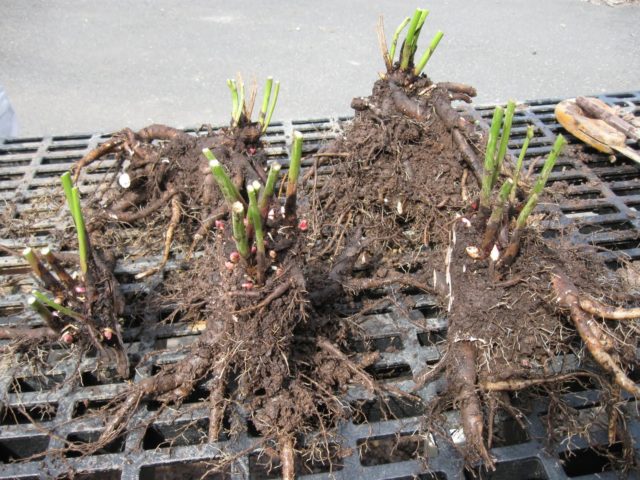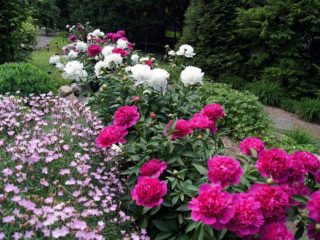Content
Peony Gardenia was bred in the USA in 1955 and is still popular among gardeners. In beauty, this variety can be compared with roses, but it is less whimsical, and is decorative not only during the flowering period, because a strong bush decorates the garden with an openwork crown.
Description of the Gardenia peony variety
The perennial bush is formed by thin but stable stems and peduncles that do not require additional support even with abundant flowering. Thanks to the strength of the stems, the plant, reaching a height of 90 cm, retains its shape well. Its width does not exceed 50 cm. The Gardenia variety grows quite quickly, but flowering can be expected no earlier than three years after planting, since in the first years all efforts are spent on the formation of the root system.
The leaves of the herbaceous peony Gardenia are large, pinnately dissected. In autumn they change their characteristic dark green color to a noble crimson.
Peony is a sun-loving perennial - only in open spaces will its flowering be long and abundant.
Like some other varieties, Gardenia is extremely frost-resistant and can withstand temperatures as low as -40 °C. Also among the undoubted advantages of the culture is drought resistance.Thanks to these characteristics, the plant thrives not only in the southern and central regions of Russia, but also in Siberia and Transbaikalia.
Features of flowering
The variety of milky-flowering peony Gardenia belongs to the group of double pink peonies. It is distinguished by large (up to 22 cm) hemispherical single flowers formed by a large number of concave petals. The shape resembles gardenia flowers, which is how the variety got its name. At first the petals are white with a slight pinkish tint, but over time they become creamy. The flowers have a light, pleasant aroma.

Large white flowers against the background of rich green leaves look very elegant
One of the features of the Gardenia variety is a large number of lateral buds, which ensures abundant long-term flowering from late spring to mid-summer.
Poor flowering of a plant or its complete absence can be caused by the following factors:
- insufficient amount of sunlight;
- unsuitable soil chemical composition;
- weak root penetration;
- errors in care.
Application in design
In landscape compositions, Gardenia peonies are planted both separately and in compositions with other varieties of this perennial.

The combination of large white flowers with buds of other shades looks great
A lush flower bed can decorate any part of the garden, but it will look especially advantageous near bodies of water - the reflection of flowering bushes in the water creates a unique romantic landscape.

Peony Gardenia can also perform as a soloist
In this case, it is planted on lawns and lawns, against which its beauty is especially visible. Flowers and conifers provide shade.
Since the Gardenia peony invariably attracts attention, other flowers may fade against its background, so perennials with other flowering periods would be an excellent option for an ensemble with it.

Delphiniums, asters, carnations, irises, and bells go well with this perennial
Since Gardenia peony bushes reach quite large sizes, they are planted in the second row in compositions.
It is better not to combine peonies with other large flowering plants, such as roses, as they will compete for attention and the beauty may fade.
Many gardeners try to grow peonies in containers, flowerpots or pots. Typically, low-growing varieties are used for these purposes. The Gardenia variety forms a full-fledged bush with a large root system, so it is quite difficult to create conditions for it to grow in a pot on the balcony. You can grow Gardenia peony in large containers, the main thing is to provide it with the right wintering conditions.
Reproduction methods
The main method of propagating Gardenia peonies is by dividing the bush. Mature plants with a well-developed root system are divided into several parts and planted.

A peony division is part of the root system with the remains of stems
As is the case with other varietal peonies, seed propagation is ineffective, since plants obtained in this way do not inherit the characteristics of the mother bush.
Landing rules
For the Gardenia peony, it is best to choose sunny areas or places with slight shading during the daytime. In the shade, the plant will not die, but it will bloom weakly or stop altogether. It is advisable to plant peonies away from buildings and large trees to ensure good air circulation for the plantings. For the same reason, bushes should be placed at a distance of at least 1 m from each other.
The optimal substrate for perennials will be fertile, loose loams with weak acidity. Too acidic soils are limed, sand is added to heavy clay soils, and sandy soils are improved by adding clay. Places with close groundwater should be avoided.

It is better to buy cuttings for planting in nurseries or specialized stores
Planting material is obtained from young plants that have reached flowering age. The root system of the division should be well developed and have 3–5 buds. Plants with wet, rotten cuts, plaque, growths and knotty thickenings on the roots are not suitable for planting.
Many gardeners prefer to plant these flowers in the fall, since in the spring there is a danger of not having enough time before the growing season begins.
Correct planting of peonies is carried out according to the following algorithm:
- 25–30 days before the expected planting date, dig a hole with a diameter and depth of about 60 cm;
- a nutritious soil mixture is prepared from leaf soil, peat, humus and sand, wood ash and superphosphate are added to it;
- planting holes are filled 2/3 with the nutrient mixture;
- the plant is positioned so that the buds are buried 4–5 cm;
- Water thoroughly and mulch with peat.
Aftercare
Any gardener can easily handle caring for the Gardenia peony. Plantings need to be provided with watering.Despite the fact that this plant tolerates drought well, it needs soil moisture during budding, during flowering and during autumn bud formation. One bush should have 2-3 buckets of water.
Young Gardenia peonies that have not yet bloomed are fed by foliar feeding. Mineral complexes are applied to adult specimens three times per season: in early spring, during the formation of buds and after flowering.
The root system of the Gardenia peony does not tolerate dense soil, so the plant needs regular loosening.
Mulching helps to significantly facilitate the care of plantings - it prevents the growth of weeds, prevents soil compaction after watering, improves the quality of the substrate, and also retains moisture.
Preparing for winter
Preparing the Gardenia peony for winter is not difficult: with the first frost, the dead stems are cut flush with the ground, and the root system is well watered. Usually this is enough for a frost-resistant perennial, but in the northern regions, with the arrival of stable frosts, you can additionally mulch the planting site with compost, peat or spruce branches.
Pests and diseases
Like other varieties of peonies, the Gardenia variety is resistant to diseases, however, for weakened plants that are not provided with proper care, fungal infections pose a danger. The best prevention would be timely watering and fertilizing, as well as removing weeds and loosening the soil around the plant. If the bushes are affected by fungi, treat them with fungicides (copper sulfate, copper oxychloride, Bordeaux mixture, Fundazol).
Ants and aphids pose a danger to flowers.You can cope with them with the help of insecticides (Actellik).

Ants attack peony leaves and transmit aphids
Conclusion
Peony Gardenia is a bright representative of the peony family. Its beautiful bushes, strewn with large white flowers, will not leave anyone indifferent. Resistance to diseases, the ability to withstand even harsh winters, as well as ease of care invariably attract many gardeners, so it’s rare that a plot can do without this “king of the garden.”








